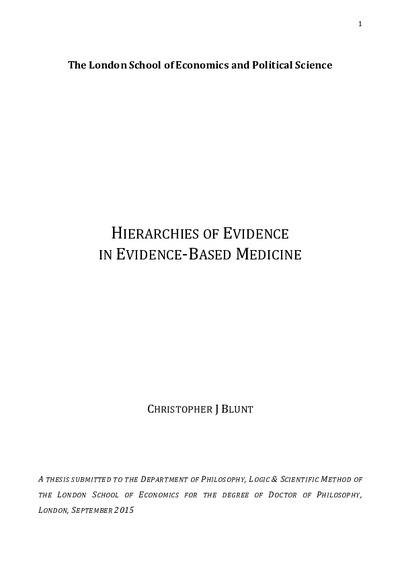Hierarchies of evidence in evidence-based medicine |

|
 Diese Seite wurde seit 2 Jahren inhaltlich nicht mehr aktualisiert.
Unter Umständen ist sie nicht mehr aktuell.
Diese Seite wurde seit 2 Jahren inhaltlich nicht mehr aktualisiert.
Unter Umständen ist sie nicht mehr aktuell.
 Zusammenfassungen
Zusammenfassungen
 Hierarchies of evidence are an important and influential tool for appraising evidence in medicine. In recent years, hierarchies have been formally adopted by organizations including the Cochrane Collaboration [1], NICE [2,3], the WHO [4], the US Preventive Services Task Force [5], and the Australian NHMRC [6,7]. The development of such hierarchies has been regarded as a central part of Evidence-Based Medicine (e.g. [8-10]), a movement within healthcare which prioritises the use of epidemiological evidence such as that provided by Randomised Controlled Trials (RCTs). Philosophical work on the methodology of medicine has so far mostly focused on claims about the superiority of RCTs, and hence has largely neglected the questions of what hierarchies are, what assumptions they require, and how they affect clinical practice. This thesis shows that there is great variation in the hierarchies defended and in the interpretations they are, and can be, given. The interpretative assumptions made in using hierarchies are crucial to the content and defensibility of the underlying philosophical commitments concerning evidence and medical practice. Once this variation is been identified, it becomes clear that the little philosophical work that has been done so far affects only some hierarchies, under some interpretations. Modest interpretations offered by La Caze [11], conditional hierarchies like GRADE [12-14], and heuristic approaches such as that defended by Howick et al. [15,16] all survive previous philosophical criticism. This thesis extends previous criticisms by arguing that modest interpretations are so weak as to be unhelpful for clinical practice; that GRADE and similar conditional models omit clinically relevant information, such as information about variation in treatments’ effects and the causes of different responses to therapy; and that heuristic approaches lack the necessary empirical support. The conclusion is that hierarchies in general embed untenable philosophical assumptions: principally that information about average treatment effects backed by high-quality evidence can justify strong recommendations, and that the impact of evidence from individual studies can and should be appraised in isolation. Hierarchies are a poor basis for the application of evidence in clinical practice. The Evidence-Based Medicine movement should move beyond them and explore alternative tools for appraising the overall evidence for therapeutic claims.
Hierarchies of evidence are an important and influential tool for appraising evidence in medicine. In recent years, hierarchies have been formally adopted by organizations including the Cochrane Collaboration [1], NICE [2,3], the WHO [4], the US Preventive Services Task Force [5], and the Australian NHMRC [6,7]. The development of such hierarchies has been regarded as a central part of Evidence-Based Medicine (e.g. [8-10]), a movement within healthcare which prioritises the use of epidemiological evidence such as that provided by Randomised Controlled Trials (RCTs). Philosophical work on the methodology of medicine has so far mostly focused on claims about the superiority of RCTs, and hence has largely neglected the questions of what hierarchies are, what assumptions they require, and how they affect clinical practice. This thesis shows that there is great variation in the hierarchies defended and in the interpretations they are, and can be, given. The interpretative assumptions made in using hierarchies are crucial to the content and defensibility of the underlying philosophical commitments concerning evidence and medical practice. Once this variation is been identified, it becomes clear that the little philosophical work that has been done so far affects only some hierarchies, under some interpretations. Modest interpretations offered by La Caze [11], conditional hierarchies like GRADE [12-14], and heuristic approaches such as that defended by Howick et al. [15,16] all survive previous philosophical criticism. This thesis extends previous criticisms by arguing that modest interpretations are so weak as to be unhelpful for clinical practice; that GRADE and similar conditional models omit clinically relevant information, such as information about variation in treatments’ effects and the causes of different responses to therapy; and that heuristic approaches lack the necessary empirical support. The conclusion is that hierarchies in general embed untenable philosophical assumptions: principally that information about average treatment effects backed by high-quality evidence can justify strong recommendations, and that the impact of evidence from individual studies can and should be appraised in isolation. Hierarchies are a poor basis for the application of evidence in clinical practice. The Evidence-Based Medicine movement should move beyond them and explore alternative tools for appraising the overall evidence for therapeutic claims. Diese Doktorarbeit erwähnt ...
Diese Doktorarbeit erwähnt ...
 Begriffe KB IB clear |  Hierarchie Hierarchie hierarchy
, hierarchy
,  Hierarchy of Evidence Hierarchy of Evidence
|
 Volltext dieses Dokuments
Volltext dieses Dokuments
 |  Hierarchies of evidence in evidence-based medicine: Gesamtes Buch als Volltext ( Hierarchies of evidence in evidence-based medicine: Gesamtes Buch als Volltext ( : :  , 4996 kByte; , 4996 kByte;  : :  ) ) |
 Anderswo suchen
Anderswo suchen 
 Beat und diese Dissertation
Beat und diese Dissertation
Beat hat diese Dissertation während seiner Zeit am Institut für Medien und Schule (IMS) ins Biblionetz aufgenommen. Er hat diese Dissertation einmalig erfasst und bisher nicht mehr bearbeitet. Beat besitzt kein physisches, aber ein digitales Exemplar. Eine digitale Version ist auf dem Internet verfügbar (s.o.). Aufgrund der wenigen Einträge im Biblionetz scheint er es nicht wirklich gelesen zu haben. Es gibt bisher auch nur wenige Objekte im Biblionetz, die dieses Werk zitieren.










 Biblionetz-History
Biblionetz-History